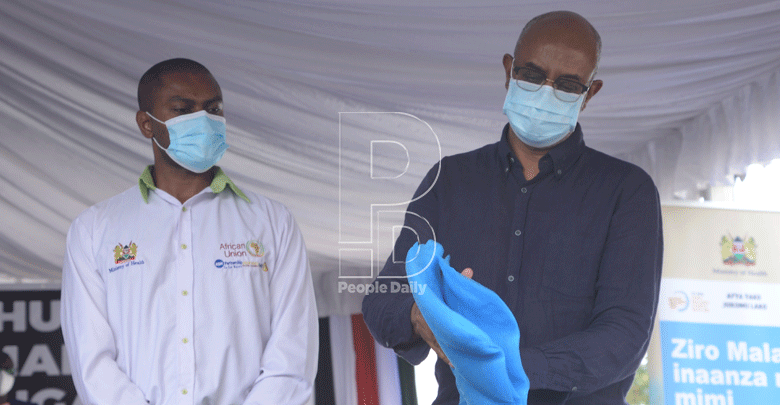Sh24b gap in fight against killer malaria

George Kebaso @Morarak
Kenya is looking for Sh24 billion to scale up malaria control activities, as the government seeks to reduce the disease incidence and deaths by 75 per cent in the next two years.
The Ministry of Health yesterday announced that the government has mooted strategies it hopes will see Kenya eliminate malaria by 2030.
Some of those strategies, the ministry said include establishment of an End Malaria Council which has elements of resource mobilisation and a platform for local manufacture of malaria nets and medicines.
Specifically, the ministry is pegging its renewed efforts on results from a national malaria indicator survey done last year, which shows the national malaria prevalence dropping from eight per cent in 2015 to 5.6 per cent in 2020.
In the Lake region; a malaria endemic site, the Kenya Malaria Indicator Survey 2020 shows that the disease prevalence dropped from 27 per cent in the same period to 19 per cent last year; and in the Coast, from eight percent to 4.5 percent.
Spray campaign
Health Cabinet Secretary (CS) Mutahi Kagwe said the outcome is impressive and shows an almost 15 per cent reduction in prevalence in the region usually with high malaria incidents.
“The results are impressive, but to succeed in our mission to end malaria, we must address financial and resource gaps that hamper the implementation of our malaria strategic plan.
We have a financial resource gap of Sh24 billion to fully implement the current Kenya Malaria Strategic Plan 2018 to 2023,” the CS said in remarks delivered by Health Chief Administrative Secretary, Rashid Aman at Afya House during the occasion to mark World Malaria Day.
He said that for the purposes of mobilising resources to spur the malaria control programme at the national level, in February this year, the End Malaria Council was inaugurated. 
“We charged the council to commence mobilisation of resources locally and drive action by the various sectors to support the implementation of Kenya’s malaria strategy; prioritise actions towards promoting and strengthening the local manufacture of malaria control commodities and identify priority activities for funding among others,” the CS said.
In the period 2015 to 2020, the Kenya Malaria Indicator Survey 2020 shows that there was increased ownership of insect treated bed nets and access to recommended malaria treatment.
“There was a decreased out-patient attendance of 30 per cent to 19 per cent, and in-patient admissions from 20 per cent to 15 per cent for people seeking treatment against malaria,” the report unveiled yesterday shows.
In the same period, the number of confirmed malaria cases decreased from 113 per 1, 000 of the population per year in 2016 to 86 per 1, 000 population per year in 2020.
Dr George Githuka, the head Division of the National Malaria Program said more efforts are geared towards ensuring reduction in malaria cases to attain the goal set to reduce malaria incidence and deaths by 75 percent of the 2016 level by 2023.
“The overall goal vision for Kenya is to have a malaria free country but this has to be done through targeted application of Indoor Residual Spraying (IRS) insecticide in eligible structures in the counties,” he added.
In view of this, the government will kick off the distribution of 15.7 million Long Lasting Insect-treated Nets (LLINs) to 27 counties in high malaria endemic areas from April 30 to July 30 with the pilot already being implemented in Kirinyaga.
“An additional 1.8 million LLINs will be distributed through the Maternal Child Health (MCH) channel targeting pregnant women and children under one year of age,” Githuka said.
The 2021 spray campaign commenced on February 15 to April 6 targeting approximately 1.7 million people in Homa Bay and Migori counties.
“IRS is one of the key interventions for malaria vector control,” he added.
In the period over 2021-2023, Kenya, Kagwe said, plans to promote the safe delivery of essential malaria services during the Covid-19 pandemic that focus on eliminating malaria by 2030.
“We intend to strengthen the use of scorecards for malaria, at community, county and national level to ensure availability of data at these levels,” he said noting that the scorecards have started to facilitate prompt decision making by the communities at highest risk.
Elimination strategy
He said the plan is to digitalise the entire data management process to enhance communities’ efficient use of data.
Dr Willis Akhwale, Senior Advisor, African Leaders Malaria Alliance said the results will guide the country to know whether it is on the right direction.
He said for the first time, Kenya has a malaria elimination strategy, interestingly to be piloted in Nyeri; Kirinyaga, Laikipia, and Nyandarua.
He said the world had set guidelines to see a 40 per ent reduction of malaria in Africa by 2020 and elimination by 2030, but this progress was interrupted in 2015.
However, despite the Covid-19 here in the country, malaria control services have been going on uninterrupted.




